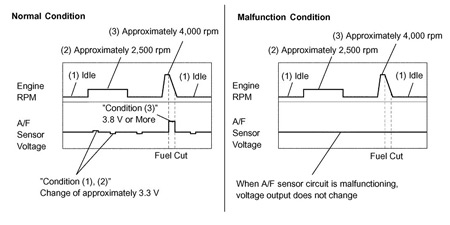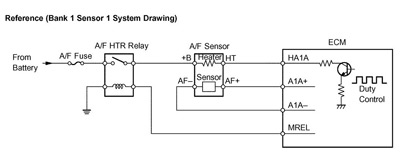You still need an interface cable to connect a laptop or PDA to the vehicle, and quarterly or annual updates from Toyota to keep your software current (see www.techinfo.toyota.com for details). But once you have the basic setup, you can do anything electronically that a Toyota dealer technician can do — except anti-theft reprogramming.
The other option for diagnostics is to use an aftermarket scan tool. For simple things like reading and clearing fault codes, or viewing sensor data, you don’t need to spend a lot of money. Almost any basic scan tool will do, provided it can read both global OBD II codes and P1 enhanced codes (including Toyota). But for more advanced diagnostic work, you need a scan tool with bidirectional capability and software that can access all the onboard systems, not just the powertrain. This includes HVAC controls, onboard navigation, communication and entertainment systems, electronic steering and suspension systems, and body control modules for power windows, doors and sunroofs.
Your scan tool should be capable of reading fault codes from all of these systems, as well as running the more commonly used self-tests that may be available on a particular vehicle (like some of the EVAP system self-tests, pulsing fuel injectors, actuating fuel pump and cooling fan relays, etc.). The scan tool may also be required for “relearn” procedures on certain systems.
What if you have to flash reprogram the PCM or another module to correct a fault? You’ll need a J2534 tool, an internet connection and a scan tool (or one with J2534 capabilities) to download and install the new software in the vehicle. There’s no reason to send customers back to the dealer for these kinds of repairs if you can learn how to do the reprogramming yourself.
RESETTING A TOYOTA STEERING ANGLE SENSOR
 A good example of a job that’s much easier with a scan tool is resetting the steering angle sensor on a 2004-’05 Toyota Camry, 4Runner, Highlander, RAV4, Sienna, Solara, Tundra or Land Cruiser with Vehicle Stability Control (VSC). On these applications, the steering column is equipped with a steering angle sensor to monitor the driver’s steering inputs. The VSC system uses this information to determine if the vehicle is responding the way the driver intends, so accurate calibration of the sensor is essential for the VSC system to do its job.
A good example of a job that’s much easier with a scan tool is resetting the steering angle sensor on a 2004-’05 Toyota Camry, 4Runner, Highlander, RAV4, Sienna, Solara, Tundra or Land Cruiser with Vehicle Stability Control (VSC). On these applications, the steering column is equipped with a steering angle sensor to monitor the driver’s steering inputs. The VSC system uses this information to determine if the vehicle is responding the way the driver intends, so accurate calibration of the sensor is essential for the VSC system to do its job.
The steering angle sensor needs to be reset if there’s a fault code related to the sensor, or if the steering sensor, yaw sensor, deceleration sensor or VSC module have been replaced. A reset also may be necessary if the wheels have been realigned, especially if the steering wheel was off-center due to toe misalignment or unequal toe adjustments.
To do the Zero Point Calibration procedure, plug the scan tool into the OBD II connector and turn the ignition key on (engine off). On the scan tool menu, choose Diagnostics, then OBD/MOBD, then Vehicle Select (and enter year, make and model), then ABS/VSC, then Reset Memory, then press Yes.
After the procedure is complete, choose Signal Check to confirm the sensor has been reset to zero. When the ABS and VSC/TRAC warning lights begin to flash, it tells you the sensor has been reset to zero. You can now exit the menu.
If you don’t have a scan tool that can access the steering sensor, fear not because Toyota has a manual procedure for doing the same thing, though the procedure takes much longer than with a scan tool.
1. Turn the ignition key on (engine off), and jump terminals Ts and CG on the DLC3 connector four times within eight seconds. The VSC light will come on indicating its memory has been cleared.
2. Turn off the ignition. Turn the key back on again. The VSC light should come on and remain on for about 15 seconds, then go off.
3. Wait two seconds, and turn the key off. Connect terminals Ts and CG again, then turn the key back on. The VSC light should come on and start to blink after about four seconds. Wait two more seconds, then turn the key off.
4. Now drive the vehicle for about five minutes so the VSC module can relearn the steering sensor zero point. That should do it.
REPROGRAMMING THE VIN ON A PCM
One job you can’t do on a Toyota without a scan tool is to reprogram the Vehicle Identification Number (VIN) in the Powertrain Control Module (PCM) if the computer has been replaced. On 2004-’06 Toyotas (any model except Corolla, Echo, Matrix or Scion), the VIN has to be programmed into the PCM, otherwise you’ll get a Check Engine light and a code P0630. This can prevent the vehicle from passing an OBD II plug-in emissions test (any codes present will cause a failure of the test).
The programming procedure requires a CAN adapter interface if the scan tool lacks CAN capabilities.
Find the VIN number on the VIN plate at the base of the windshield (driver’s side). Plug the scan tool into the OBD II connector, turn the key on, then follow these menu prompts: Diagnose, then Enhanced OBD II, then VIN, then VIN Write. Enter the VIN number (don’t make any mistakes), then verify the PCM is reading the correct VIN before turning the key off.
FALSE CODES
 Toyota tech bulletin EG009-05 says some 2004-’05 Toyota Camrys may set any of the following codes: P0031, P0052, P2238 or P2241. These are oxygen sensor heater circuit codes, but there may be nothing wrong with the sensor. The fault may be an overly sensitive OBD II self-diagnostic logic routine. The fix is to download the latest PCM update from Toyota and reflash the computer.
Toyota tech bulletin EG009-05 says some 2004-’05 Toyota Camrys may set any of the following codes: P0031, P0052, P2238 or P2241. These are oxygen sensor heater circuit codes, but there may be nothing wrong with the sensor. The fault may be an overly sensitive OBD II self-diagnostic logic routine. The fix is to download the latest PCM update from Toyota and reflash the computer.
To do this, you need to first check the calibration ID in the vehicle’s PCM using your scan tool, then compare it to the latest calibration IDs listed on the Toyota service information website. If there’s a newer calibration available, it needs to be downloaded and installed in the vehicle.
One very important tip with respect to flash reprogramming Toyota PCMs is to remove the 10A ECU-IG fuse from the fuse block assembly. This will prevent activation of the ABS relay (which shares the same circuit) from messing up the reflash, according to Toyota.




